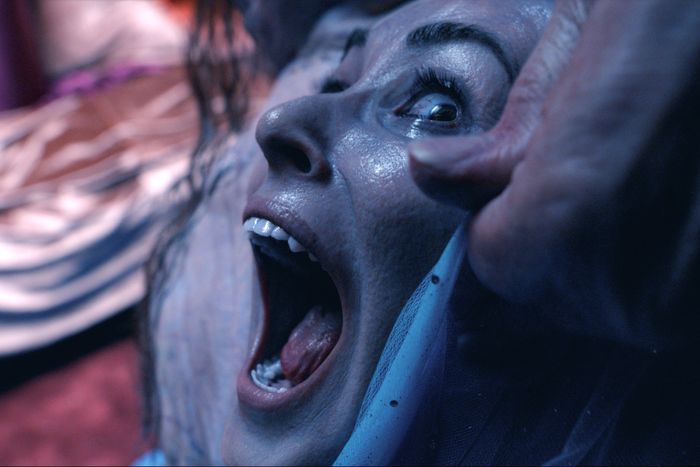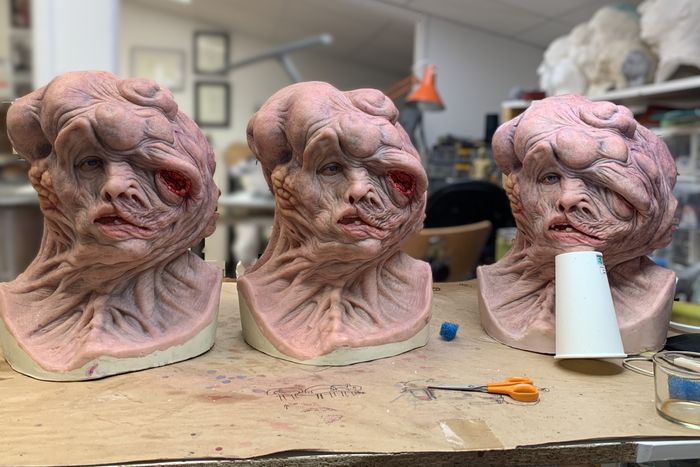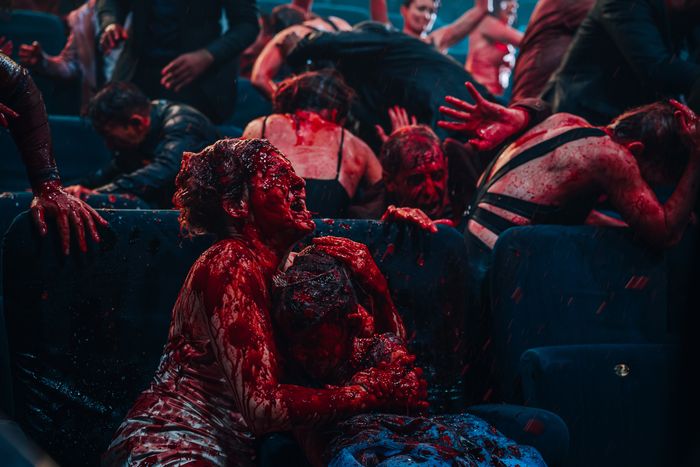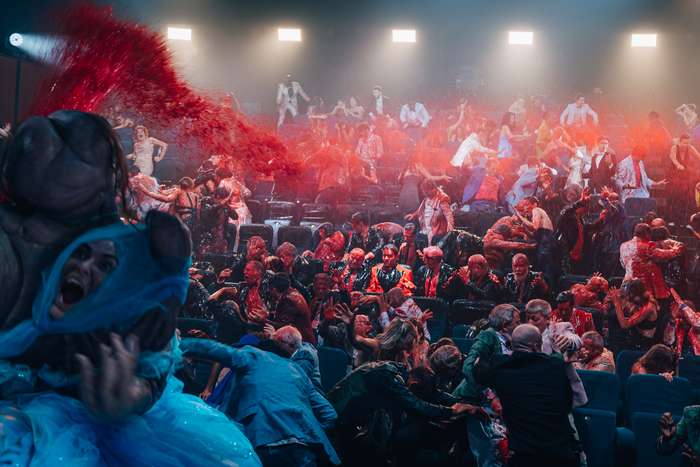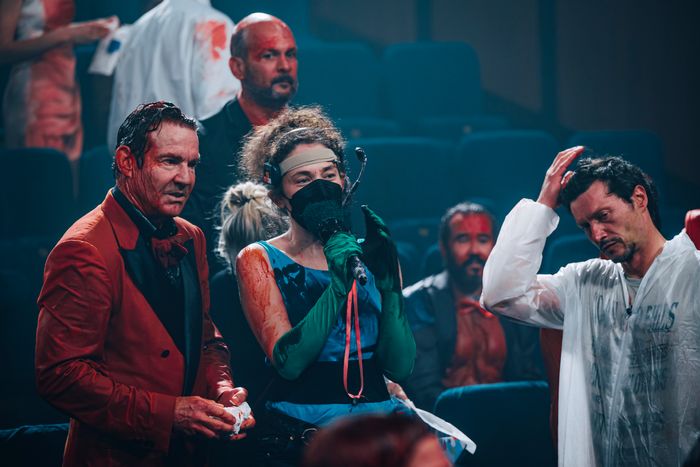
This article was published on October 7, 2024. On January 23, 2025, The Substance was nominated for five Oscars, including Best Picture and Best director for Coralie Fargeat. Spoilers for the end of The Substance follow.
The Substance, Coralie Fargeat’s outré satire about modern beauty standards, is a cautionary tale and 2024’s wildest psychodrama, in which Demi Moore and Margaret Qualley slowly transform into a modern Frankensteined wonder. When Elisabeth Sparkle (Moore), a 50-year-old actress turned TV fitness instructor, is fired by a network executive who deems her too old, she makes a Faustian bargain, injecting herself with neon-green plasma that lets her live every other week as a sexy, spotless 20-something named Sue (Qualley). But each time Sue overstays her welcome, parts of Elisabeth’s body age at punishing rates. Soon enough, she will become Monstro Elisasue, a distorted ogress who looks like Anjelica Huston in The Witches, if that movie had been 17 times more sinister.
Over two years, Fargeat worked to construct a beastly mash-up befitting the bloodbath of the film’s operatic finale. “All the things that can be seen as pieces of flesh from the outside gaze — our breasts, our ass, our teeth, our smile — were totally deconstructed, pulverized, and put in no order,” the French director says. “It’s the way society has shaped itself by the way men look at women.” This is how Elisasue came to life.
1.
The Birth
Fargeat always knew her movie would end with a monster — a “Picasso of male expectations,” as she calls it. The rejection that motivates Elisabeth to consume the Substance also fosters Sue’s addiction to remaining young, which is why Sue defies the mandate to switch bodies with Elisabeth every seven days. Elisasue is the product of minds and bodies stalked by external valuations.
Like many great movie monsters, Elisasue wants only to be loved. Fargeat drew inspiration from The Elephant Man, David Lynch’s 1980 tragedy about a deformed 19th-century Englishman who is treated as a freak-show spectacle until a sympathetic doctor takes him in. “He’s monstrous, but you want to hug him,” Fargeat says, and the same applies to Elisasue. Fargeat made mood boards featuring stills from Lynch’s movie as well as various human-animal sculptures she found online and the work of Colombian artist Fernando Botero, whose sculptures often feature women with exaggerated proportions. In her eyes, Elisasue is to The Substance what Quasimodo is to Victor Hugo’s The Hunchback of Notre-Dame.
In the script, Fargeat tried to outline Elisasue as vividly as possible, specifically her mismatched body parts — a lopsided head, teeth protruding from her chest, arms askew, Elisabeth’s stunned face bulging from her backside, lots of folds and wrinkles and aberrations. “I wanted the monster to be heavy, which contrasts so much with the dancer figure that we fantasize about being delicate with a thin waist — this kind of Princess Ariel,” Fargeat says. “I wanted her to struggle and limp.” But describing a monster on the page is one thing; putting an actress in a functioning foam-latex bodysuit that has all of these oddities built into it is another.
2.
The Transformation
Wanting to use the sort of practical effects that made ’80s horror hits like An American Werewolf in London and The Fly so visceral, Fargeat initially met with prosthetics artists who struggled to conjure her vision. “I’ve seen designs that had been done by very, very talented people, but they were very masculine,” says Pierre-Olivier Persin, a prosthetics whiz whose credits include Game of Thrones and Athena. Persin got the job thanks to a small maquette he sculpted. He and Fargeat then created the full-size Elisasue using a mix of prosthetics, puppetry, and digital renderings. On set, Fargeat and her team had five heads (including a special head with a cavity that splits open to birth a breast attached to an umbilical cord), two full bodysuits, two partial bodysuits, and a mold of Moore’s head. The work was so meticulous that Persin jokingly calls it “months of suffering.”
Qualley spent six claustrophobic hours in the makeup chair to become Elisasue. The actress found the character’s complexities “rewarding” after so much time embodying Sue’s soullessness. But the physical demands were a different story. “That was painful,” Qualley says. “A real challenge. But we got through it.”
3.
The Blowup
After Sue kills Elisabeth and returns to the TV studio to headline a New Year’s Eve special, Sue’s body starts to give out. So she abuses the Substance once again, leading to the surprise emergence of a third self. When Elisasue glimpses her repulsive reflection in the mirror, she feels a sense of victory. In Fargeat’s eyes, she can no longer see herself through any prescribed beauty standard. Only then does she find peace. Fargeat says, “She stops fighting with herself because all the pieces are blended into one being,” the director says. Moore and Fargeat think of Elisasue as a tender response to Elisabeth’s self-loathing. “She represents a reckoning and the release of the physical body,” Moore says.
At the New Year’s event, Elisasue’s body mutates in real time. After hobbling to the stage and spewing out that boob from her head to the horror of a crowd calling for her execution, her body detonates, unleashing a tsunami of blood that took two weeks to shoot. Fargeat, with a camera attached to her helmet, operated the fire hose herself. The sequence required stunt performers, 30,000 gallons of fake blood, and a technical setup the director likens to “navigating the Titanic.” They had only one chance to capture a wide shot of the audience being splattered. In The Substance’s final minutes, the last recognizable part of Elisabeth — her face, which now has Medusa-like tentacles — crawls to Elisabeth’s star on the Hollywood Walk of Fame to die.
“I knew from the start that I wanted to finish with some kind of liberating climax — something that goes very far and that is a super-cathartic gesture where you let the excess explode,” Fargeat says. “The audience, for me, represents society. I depicted Elisabeth’s genuine dream, which is to be loved by those people for who she really is. Having this explosion of blood and guts was a way to externalize the violence that I feel all those gazes and this beauty pressure put on us. It was a way for me to splatter it in the face of the audience to say, ‘Look at what you’re creating. You are responsible for this explosion.’”
More on ‘the substance’
- Who Really Won the Awards-Season Circuit?
- And the Oscar Goes to … Sue
- After-hours With the Oscars Class of 2025


